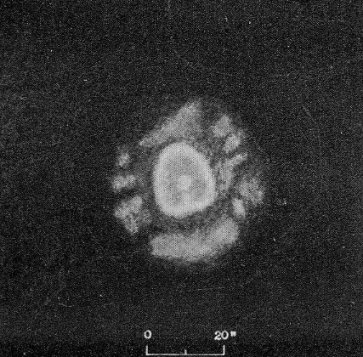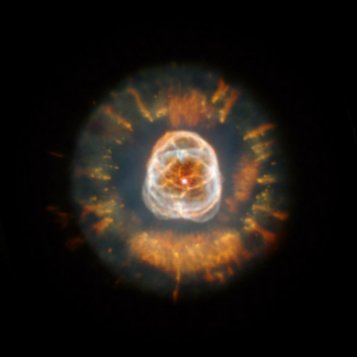NGC 2392
THE ESKIMO NEBULA
Among the most wonderfully intricate of planetary nebulae, NGC 2392 in Gemini, famously nicknamed "the Eskimo"
because of the outer "parka" that seems to surround a face, is also
among the brightest. The obvious, near-tenth magnitude (10.5)
central star quite stands out about 2.5 degrees to the east-
southeast of Delta Geminorum, and is
visible in even a small telescope. Curtis's drawing on the left,
a composite of several photos, bears a remarkable visual
resemblance to the spectacular Hubble view on the right (the latter
slightly tilted to the right from north). NGC 2392 is also the
champion of the double-shell nebulae (another fine example of which
is NGC 7662), wherein the inner shell
seems to have been compressed from the surrounding matter by a hot
wind, and the outer shell shows the "comet-like" structures so
easily seen in the Helix (NGC 7293). With a little imagination,
the inner ring rather jumps out as a three-dimensional sphere.
The distance, not really known, seems to fall between 2000 and 4000
light years. The inner shell is about 16 seconds of arc across,
the outer about double that. If at 3000 light years distance, the
inner regions is then about a quarter of a light year wide. The
inner portion has an unusually high expansion velocity of 53
kilometers per second, more than double the usual value.
At 65,000 Kelvin, the central star is only (for planetary nebulae)
modestly hot, while the luminosity is in the thousands of Suns.
Left: Image by H. D. Curtis from Publications of the Lick
Observatory, Volume 13, Part III, 1918. Right: NASA, Andrew
Fruchter and the ERO Team [Sylvia Baggett (STScI, Richard Hook (ST-
ECF), Zoltan Levay (STScI)].



